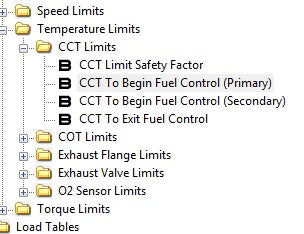Thread Starter
#81
Thread Starter
#81
And some more:
No problem, if there is any other information you need please let me know I will post it.
Another thing I wanted to mention is CCT, which is Catalyst Temper. This is an inferred reading from multiple parameters that are being monitored by the ECU. You can also monitor it yourself with the Cobb Accessport if you would like. There are tables in the software (See below) that have thresholds set. If these thresholds are exceeded they have a protocol to introduce more fuel for cylinder temperature control. I monitor this via a gauge when tuning to see how close I am getting to the threshold, this also gives me reason to believe that the factory downpipe and catalyst flow very well. During my tuning the temperature never increased beyond the factory range, and was still 20-25% away from being anywhere near the thresholds set. This tells me that with the increase in boost, fuel, and timing that the cat is not increasing in temperature and is not holding exhaust gases due to a restriction.

First Table: CCT Limit Safety Factor - This is the threshold that is put in place to make fuel control protocols active. It
Second Table: CCT To Begin Fuel Control (Primary) - This is the temperature ceiling set to activate the primary injection of fuel to decrease CCT.
Third Table: CCT To Begin Fuel Control (Secondary) - Same as Primary above, but the "backup" just in case the primary protocol can't cool the catalyst temperatures.
Fourth Table: CCT To Exit Fuel Control - The temperature that the catalyst needs to return to to cancel both Primary or Secondary injections.
Well stated guys!
[HR][/HR]
To add to this COBB (for example) strongly suggests having either a highflow catted downpipe or non-catted DP installed when using their stg3 OTS Map...There is no mention that installing their DP alone will produce gains...I suspect the rationale for doing so has moreso to do with the reasons already stated above...
I've reviewed the differences between COBB's stg1 and stg 3 OTS maps (through Cobb ATR) and the 2 primary changes made between the two maps are that timing is advanced by ~4.0 degrees (>5000rpm / > 1.6% load) and maximum boost is increased by another 2.0 psi...This will greatly increase EGTs where I can see where installing a highflow DP would be a wise choice as not to damage the stock CAT... Also boost response and spooling efficiency should great be improved and as mentioned by others earlier by not placing as much strain on the FiSTs stock turbo at these higher boost levels....
That said...It should be of no surprise that installing a non-catted DP on a stg1 tune would show any significant increase to hp....
[HR][/HR]
And thanks for posting this Adam!
[HR][/HR]
To add to this COBB (for example) strongly suggests having either a highflow catted downpipe or non-catted DP installed when using their stg3 OTS Map...There is no mention that installing their DP alone will produce gains...I suspect the rationale for doing so has moreso to do with the reasons already stated above...
I've reviewed the differences between COBB's stg1 and stg 3 OTS maps (through Cobb ATR) and the 2 primary changes made between the two maps are that timing is advanced by ~4.0 degrees (>5000rpm / > 1.6% load) and maximum boost is increased by another 2.0 psi...This will greatly increase EGTs where I can see where installing a highflow DP would be a wise choice as not to damage the stock CAT... Also boost response and spooling efficiency should great be improved and as mentioned by others earlier by not placing as much strain on the FiSTs stock turbo at these higher boost levels....
That said...It should be of no surprise that installing a non-catted DP on a stg1 tune would show any significant increase to hp....
[HR][/HR]
And thanks for posting this Adam!
Another thing I wanted to mention is CCT, which is Catalyst Temper. This is an inferred reading from multiple parameters that are being monitored by the ECU. You can also monitor it yourself with the Cobb Accessport if you would like. There are tables in the software (See below) that have thresholds set. If these thresholds are exceeded they have a protocol to introduce more fuel for cylinder temperature control. I monitor this via a gauge when tuning to see how close I am getting to the threshold, this also gives me reason to believe that the factory downpipe and catalyst flow very well. During my tuning the temperature never increased beyond the factory range, and was still 20-25% away from being anywhere near the thresholds set. This tells me that with the increase in boost, fuel, and timing that the cat is not increasing in temperature and is not holding exhaust gases due to a restriction.

First Table: CCT Limit Safety Factor - This is the threshold that is put in place to make fuel control protocols active. It
Second Table: CCT To Begin Fuel Control (Primary) - This is the temperature ceiling set to activate the primary injection of fuel to decrease CCT.
Third Table: CCT To Begin Fuel Control (Secondary) - Same as Primary above, but the "backup" just in case the primary protocol can't cool the catalyst temperatures.
Fourth Table: CCT To Exit Fuel Control - The temperature that the catalyst needs to return to to cancel both Primary or Secondary injections.

![Cool [8D] [8D]](/images/smilies/cool.gif)
![Shhh! [shhh] [shhh]](/images/smilies/shhh.gif)